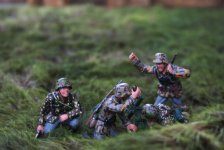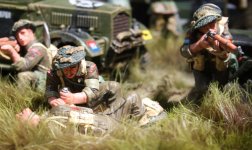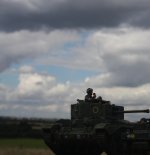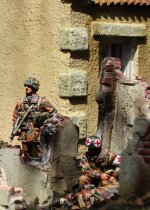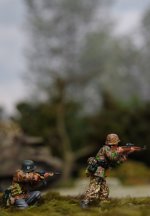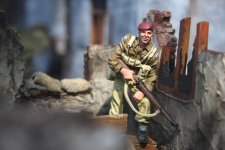You are using an out of date browser. It may not display this or other websites correctly.
You should upgrade or use an alternative browser.
You should upgrade or use an alternative browser.
Battle for Arnhem.... (8 Viewers)
- Thread starter panda1gen
- Start date
panda1gen
Major
- Joined
- Jul 29, 2005
- Messages
- 6,347
Continued from page 100 in this new format. I shall try to keep the diodrama format going, not just post pictures.
The battles fought by the Guards to break through the German defences ...
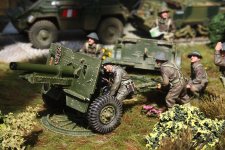
..... and the Screaming Eagle’s marching and counter marching to keep twenty miles of Hell’s Highway open, is justifiably one of the Northwest European Campaign’s most remembered battles.
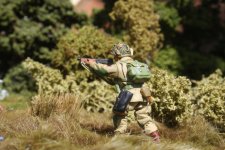
The 101st Airborne and the Guards Armoured Divisions fought together heroically, supported by the West Countrymen of 231 Brigade and other British armoured units.
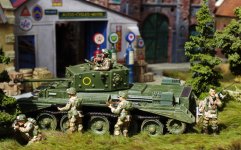
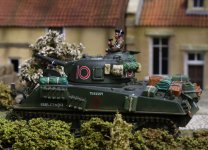
These very different formations faced odds that, if fully realized by Montgomery’s MARKET GARDEN planners and SHAEF, would have been considered impossible. Like tipping dominos over whilst lined up next to each other, each event would in turn affect another part of the complex operation disastrously and tip it over.
For example, the cumulative delays imposed by the blowing of the Son Bridge and the other cuts to the route north, were to have a profound effect on the operations of British and American divisions at Nijmegen and on The Island, which would in turn would cripple 1st Airborne, trapped and isolated as they were across one of Europe’s great rivers.
The Germans managed to repair and concentrate enough force to create real opposition, at a level not expected after the collapse in Normandy (and the enormous losses in Russia).
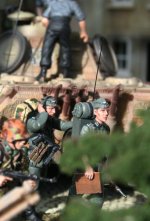
The battles fought by the Guards to break through the German defences ...

..... and the Screaming Eagle’s marching and counter marching to keep twenty miles of Hell’s Highway open, is justifiably one of the Northwest European Campaign’s most remembered battles.

The 101st Airborne and the Guards Armoured Divisions fought together heroically, supported by the West Countrymen of 231 Brigade and other British armoured units.


These very different formations faced odds that, if fully realized by Montgomery’s MARKET GARDEN planners and SHAEF, would have been considered impossible. Like tipping dominos over whilst lined up next to each other, each event would in turn affect another part of the complex operation disastrously and tip it over.
For example, the cumulative delays imposed by the blowing of the Son Bridge and the other cuts to the route north, were to have a profound effect on the operations of British and American divisions at Nijmegen and on The Island, which would in turn would cripple 1st Airborne, trapped and isolated as they were across one of Europe’s great rivers.
The Germans managed to repair and concentrate enough force to create real opposition, at a level not expected after the collapse in Normandy (and the enormous losses in Russia).

panda1gen
Major
- Joined
- Jul 29, 2005
- Messages
- 6,347
Ref: Battleground Europe - Operation Market Garden
Hell’s Highway - By Tim Saunders
The following is essentially copied from the above work. I have no knowledge as to whether this information is currently accurate or not.
APPENDIX
CEMETERIES - The MARKET GARDEN Graves
The soldiers of all nations who took part in MARKET GARDEN and were killed in action or died of wounds are now widely spread across Europe, Britain and the USA. However, a significant number still lie on cemeteries on or near the battlefields covered by this book.
The Commonwealth War Graves Commission (CWGC)
The Commonwealth War Commission was formed in 1917, originally as the Imperial War Graves Commission, under Major General Sir Fabian Ware.
As commander of a Red Cross mobile unit, Ware started to record names and locations of graves, which at the time, beyond a wooden cross went largely unrecorded despite Army regulations. Good intentions, however, broke down in the chaos and under the weight of casualties. Under pressure from home, the War Office approved the formation of a Graves Registration Unit in 1915, under Ware, who became a Temporary Major.
Gradually the importance of care of war graves grew and in 1917 the present organization was founded. Today the Commission works in 140 countries and tends 1,146,105 graves and maintains memorials to many thousands more Commonwealth Soldiers who lost their lives in the Twentieth Century.
General Haig commented in 1915:
‘It is recognized that the work of the organization is of purely sentimental value, and that it does not directly contribute to the successful termination of the war. It has, however, an extraordinary moral value to the troops as well as to the relatives and friends of the dead at home... Further, on the termination of hostilities, the nation will demand an account from the government as to the steps which have been taken to mark and classify the burial places of the dead...’
CWGC Cemetery Leopoldsburg
This cemetery is hard to find, as it is located off the main N73 road, on the outskirts of a Belgian Army Garrison near Leopoldsburg and is poorly signed. There are 767 graves, many of which are from the period of the advance from Brussels to the Escaut Canal, which culminated in the seizure of Joe’s bridge. Other graves date from later in the campaign, when a field hospital was located in the nearby barracks.
CWGC Cemetery Valkenswaard
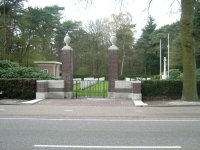
This small woodland cemetery is located on the N69 between Joe’s Bridge and Valkenswaard itself. The cemetery was originally formed by the Irish Guards for the burial of soldiers killed on the opening day of MARKKET GARDEN. There are 222 British soldiers and two airmen, of whom thirty were killed on 17 or 18 September.
The largest single regimental representation is the sixteen Irish Guardsmen killed during the breakout. They are buried very close to where they died in the German tank ambush on that Sunday afternoon.
Also heavily represented are 2/Devons of 231 Brigade with eleven graves. These soldiers were killed while clearing the enemy from the surrounding woods as they advanced, on foot, parallel to the road. The remainder of the graves are mainly from the MARKET GARDEN period but are not exclusively from XXX Corps.
CWGC Eindhoven Woensel Civilian Cemetery
Having just turned off the Eindhoven inner ring road onto the John F Kennedy road keep an eye open for the green and white CWGC sign, on the left, indicating the Wonsel Cemetery. The CWGC plot containing 666 burials is an extension of the civilian cemetery
CWGC Cemetery Uden
There are 699 burials, the cemetery is signed from N265 Uden bypass. A high proportion of the burials date from the MARKET GARDEN period.
Hell’s Highway - By Tim Saunders
The following is essentially copied from the above work. I have no knowledge as to whether this information is currently accurate or not.
APPENDIX
CEMETERIES - The MARKET GARDEN Graves
The soldiers of all nations who took part in MARKET GARDEN and were killed in action or died of wounds are now widely spread across Europe, Britain and the USA. However, a significant number still lie on cemeteries on or near the battlefields covered by this book.
The Commonwealth War Graves Commission (CWGC)
The Commonwealth War Commission was formed in 1917, originally as the Imperial War Graves Commission, under Major General Sir Fabian Ware.
As commander of a Red Cross mobile unit, Ware started to record names and locations of graves, which at the time, beyond a wooden cross went largely unrecorded despite Army regulations. Good intentions, however, broke down in the chaos and under the weight of casualties. Under pressure from home, the War Office approved the formation of a Graves Registration Unit in 1915, under Ware, who became a Temporary Major.
Gradually the importance of care of war graves grew and in 1917 the present organization was founded. Today the Commission works in 140 countries and tends 1,146,105 graves and maintains memorials to many thousands more Commonwealth Soldiers who lost their lives in the Twentieth Century.
General Haig commented in 1915:
‘It is recognized that the work of the organization is of purely sentimental value, and that it does not directly contribute to the successful termination of the war. It has, however, an extraordinary moral value to the troops as well as to the relatives and friends of the dead at home... Further, on the termination of hostilities, the nation will demand an account from the government as to the steps which have been taken to mark and classify the burial places of the dead...’
CWGC Cemetery Leopoldsburg
This cemetery is hard to find, as it is located off the main N73 road, on the outskirts of a Belgian Army Garrison near Leopoldsburg and is poorly signed. There are 767 graves, many of which are from the period of the advance from Brussels to the Escaut Canal, which culminated in the seizure of Joe’s bridge. Other graves date from later in the campaign, when a field hospital was located in the nearby barracks.
CWGC Cemetery Valkenswaard

This small woodland cemetery is located on the N69 between Joe’s Bridge and Valkenswaard itself. The cemetery was originally formed by the Irish Guards for the burial of soldiers killed on the opening day of MARKKET GARDEN. There are 222 British soldiers and two airmen, of whom thirty were killed on 17 or 18 September.
The largest single regimental representation is the sixteen Irish Guardsmen killed during the breakout. They are buried very close to where they died in the German tank ambush on that Sunday afternoon.
Also heavily represented are 2/Devons of 231 Brigade with eleven graves. These soldiers were killed while clearing the enemy from the surrounding woods as they advanced, on foot, parallel to the road. The remainder of the graves are mainly from the MARKET GARDEN period but are not exclusively from XXX Corps.
CWGC Eindhoven Woensel Civilian Cemetery
Having just turned off the Eindhoven inner ring road onto the John F Kennedy road keep an eye open for the green and white CWGC sign, on the left, indicating the Wonsel Cemetery. The CWGC plot containing 666 burials is an extension of the civilian cemetery
CWGC Cemetery Uden
There are 699 burials, the cemetery is signed from N265 Uden bypass. A high proportion of the burials date from the MARKET GARDEN period.
panda1gen
Major
- Joined
- Jul 29, 2005
- Messages
- 6,347
American Battle Monuments Commission
Similar to the Commonwealth War Graves Commission, the American Battle Monuments Commission (ABMC) is an agency of the Executive Branch of the US federal government. It is responsible for commemorating the service of US Forces’ world-wide since April 1917 (their entry into World War I) by establishing suitable memorials and constructing, operating and maintaining permanent American military cemeteries overseas.
The ABMC is also responsible for controlling the design and construction of U.S. military monuments and markers in foreign countries erected by other US citizens and organizations, both public and private; and overseeing their maintenance.
In 1947, the US Congress decided to give next of kin the option to choose where they would like the serviceman to be buried (unlike the Commonwealth next of kin). The choices were to remain in the theatre where they died or to return them to the US for burial in National Military Cemeteries or under private arrangements in hometown cemeteries.
About 63% of all bodies were repatriated during 1948 and 1949. The remaining US military graves were concentrated into a few large cemeteries. Of the 320,423 Second World War bodies of US servicemen, the ABMC is responsible for 93,242 graves across the world. The remainder of the bodies were returned to their families. Also commemorated by the ABMC are the names of 78,976 soldiers who are listed as Missing in Action.
Margraten Cemetery
Margraten is the only ABMC cemetery in Holland. The dead who were to remain in the care of the ABMC were brought here from temporary cemeteries across Holland, such as that at Mollenhoek at the foot of the Grossbeck heights. The cemetery is situated in the village of Margraten, six miles east of Maastricht near the southernmost point of Holland some two hours drive south of Nijmegen. The Cemetery is well signposted. Margarten’s tall memorial tower is clearly visible as the visitor approaches the site, which covers over sixty acres. From the cemetery entrance, the visitor enters the Court of Honour with its pool reflecting the tower. To the right and left, respectively, are the visitors’ building and a building containing on its walls three engraved maps showing the operations conducted by US Forces in 1944 and 1945.
Stretching along the side of the Court are the two Walls of the Missing on which are recorded the names of 1,723 who gave their lives in the service of the USA but who rest in unknown graves. At the base of the tower, facing the reflecting pool is a statue representing the grieving mother of her lost son. Beyond the tower, containing the cemetery’s chapel is the burial area. Divided into 16 plots the cemetery contains 8,301 graves, with the headstones set in long curves. A wide tree-lined mall leads to the flagstaff.
In the summer, the cemetery is open to visitors daily from 09.00 - 18.00 hours and in the winter from 09.00 to 17.00 hours. Details of the ABMC its work and cemeteries can be found on its website.
http:// www.usabmc.com/index.shtml
Similar to the Commonwealth War Graves Commission, the American Battle Monuments Commission (ABMC) is an agency of the Executive Branch of the US federal government. It is responsible for commemorating the service of US Forces’ world-wide since April 1917 (their entry into World War I) by establishing suitable memorials and constructing, operating and maintaining permanent American military cemeteries overseas.
The ABMC is also responsible for controlling the design and construction of U.S. military monuments and markers in foreign countries erected by other US citizens and organizations, both public and private; and overseeing their maintenance.
In 1947, the US Congress decided to give next of kin the option to choose where they would like the serviceman to be buried (unlike the Commonwealth next of kin). The choices were to remain in the theatre where they died or to return them to the US for burial in National Military Cemeteries or under private arrangements in hometown cemeteries.
About 63% of all bodies were repatriated during 1948 and 1949. The remaining US military graves were concentrated into a few large cemeteries. Of the 320,423 Second World War bodies of US servicemen, the ABMC is responsible for 93,242 graves across the world. The remainder of the bodies were returned to their families. Also commemorated by the ABMC are the names of 78,976 soldiers who are listed as Missing in Action.
Margraten Cemetery
Margraten is the only ABMC cemetery in Holland. The dead who were to remain in the care of the ABMC were brought here from temporary cemeteries across Holland, such as that at Mollenhoek at the foot of the Grossbeck heights. The cemetery is situated in the village of Margraten, six miles east of Maastricht near the southernmost point of Holland some two hours drive south of Nijmegen. The Cemetery is well signposted. Margarten’s tall memorial tower is clearly visible as the visitor approaches the site, which covers over sixty acres. From the cemetery entrance, the visitor enters the Court of Honour with its pool reflecting the tower. To the right and left, respectively, are the visitors’ building and a building containing on its walls three engraved maps showing the operations conducted by US Forces in 1944 and 1945.
Stretching along the side of the Court are the two Walls of the Missing on which are recorded the names of 1,723 who gave their lives in the service of the USA but who rest in unknown graves. At the base of the tower, facing the reflecting pool is a statue representing the grieving mother of her lost son. Beyond the tower, containing the cemetery’s chapel is the burial area. Divided into 16 plots the cemetery contains 8,301 graves, with the headstones set in long curves. A wide tree-lined mall leads to the flagstaff.
In the summer, the cemetery is open to visitors daily from 09.00 - 18.00 hours and in the winter from 09.00 to 17.00 hours. Details of the ABMC its work and cemeteries can be found on its website.
http:// www.usabmc.com/index.shtml
panda1gen
Major
- Joined
- Jul 29, 2005
- Messages
- 6,347
German
The German MARKET GARDEN dead are widely spread in cemeteries across the border in Germany or in the German Deutsche Kriegsgrabefürsorge cemetery at Lommel near Joe’s Bridge in Belgium or in Holland at Ijsselstijn.
Lommel German Cemetery
Turn left in, at the cross roads before reaching Joe’s Bridge. Head towards Hasselt and follow the white signs with black text ‘Deutscher Soldaten Friedhof’ to the cemetery. Originally an American temporary cemetery, this attractively laid out cemetery contains 542 graves dating back to the First World War.
In 1947, once the American dead had been repatriated, no less than 38,614 German bodies were concentrated here from four other cemeteries in Belgium.
Ijsselstijn German Cemetery
Ijsselstijn German War Cemetery is sited in a remote spot thirty kilometres west of Eindhoven between that city and Venray. Follow the A270 from Eindhoven to Helmond where the road turns into the N270. Continue until the junction with the N277 is reached. Ijsseltijn is a mile to the south on the N277.
German soldiers who died and were originally buried in Holland between 1940 and 1945, were disinterred after the war and moved from communal or battlefield cemeteries across Holland and concentrated here for reburial. There are 31,511 bodies interned in this cemetery.
Many of the soldiers who lay here, are those of the 8,000 (approximately) Germans killed during Operation MARKET GARDEN. Those from II SS Panzer Corps killed in Arnhem and on the Island were originally buried in the SS Heroes Cemetery on the outskirts of Arnhem. In line with normal policy, SS ranks have been converted into their Wehrmacht equivalents on all graves and memorials.
The German MARKET GARDEN dead are widely spread in cemeteries across the border in Germany or in the German Deutsche Kriegsgrabefürsorge cemetery at Lommel near Joe’s Bridge in Belgium or in Holland at Ijsselstijn.
Lommel German Cemetery
Turn left in, at the cross roads before reaching Joe’s Bridge. Head towards Hasselt and follow the white signs with black text ‘Deutscher Soldaten Friedhof’ to the cemetery. Originally an American temporary cemetery, this attractively laid out cemetery contains 542 graves dating back to the First World War.
In 1947, once the American dead had been repatriated, no less than 38,614 German bodies were concentrated here from four other cemeteries in Belgium.
Ijsselstijn German Cemetery
Ijsselstijn German War Cemetery is sited in a remote spot thirty kilometres west of Eindhoven between that city and Venray. Follow the A270 from Eindhoven to Helmond where the road turns into the N270. Continue until the junction with the N277 is reached. Ijsseltijn is a mile to the south on the N277.
German soldiers who died and were originally buried in Holland between 1940 and 1945, were disinterred after the war and moved from communal or battlefield cemeteries across Holland and concentrated here for reburial. There are 31,511 bodies interned in this cemetery.
Many of the soldiers who lay here, are those of the 8,000 (approximately) Germans killed during Operation MARKET GARDEN. Those from II SS Panzer Corps killed in Arnhem and on the Island were originally buried in the SS Heroes Cemetery on the outskirts of Arnhem. In line with normal policy, SS ranks have been converted into their Wehrmacht equivalents on all graves and memorials.
panda1gen
Major
- Joined
- Jul 29, 2005
- Messages
- 6,347
I left the stories from 1st Airborne at Arnhem on page 90 in the new forum format, to cover the 101st and XXX Corps as they tried to advance.
I shall now return to 1st Airborne at and around Arnhem. I shall also return to using:
Arnhem - 1944: The Airborne Battle by M. Middlebrook ... as a primary (but not exclusive reference).
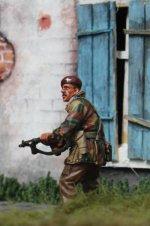
I shall now return to 1st Airborne at and around Arnhem. I shall also return to using:
Arnhem - 1944: The Airborne Battle by M. Middlebrook ... as a primary (but not exclusive reference).

panda1gen
Major
- Joined
- Jul 29, 2005
- Messages
- 6,347
To recap:
By the end of Tuesday the 19th, of the five battalions and one brigade headquarters which had gone into Arnhem, more than 3,000 men, and no more than 500 returned to Oosterbeek. About 700 were still fighting two miles away at the bridge.
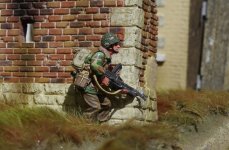
About 120 of those missing had been killed, leaving nearly 1,700 men as prisoners (many wounded) or being hidden by Dutch people.
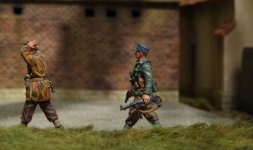
1st Airborne Division lost one-fifth of its total strength in those streets and open spaces beside the Rhine in Arnhem. The remnants of the four battalions which returned were commanded by two majors, one captain (slightly wounded) and one lieutenant.
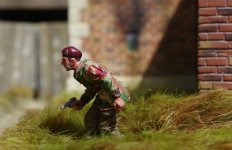
That railway embankment between Arnhem and Oosterbeek can represent a boundary between the hell of west Arnhem in that period and the comparative calm, until now, of Oosterbeek. It can also mark the end of this description of that desperate phase of the Arnhem battle.
By the end of Tuesday the 19th, of the five battalions and one brigade headquarters which had gone into Arnhem, more than 3,000 men, and no more than 500 returned to Oosterbeek. About 700 were still fighting two miles away at the bridge.

About 120 of those missing had been killed, leaving nearly 1,700 men as prisoners (many wounded) or being hidden by Dutch people.

1st Airborne Division lost one-fifth of its total strength in those streets and open spaces beside the Rhine in Arnhem. The remnants of the four battalions which returned were commanded by two majors, one captain (slightly wounded) and one lieutenant.

That railway embankment between Arnhem and Oosterbeek can represent a boundary between the hell of west Arnhem in that period and the comparative calm, until now, of Oosterbeek. It can also mark the end of this description of that desperate phase of the Arnhem battle.
panda1gen
Major
- Joined
- Jul 29, 2005
- Messages
- 6,347
One feature of the treatment of the Battle of Arnhem, is that by describing significant actions through to their conclusion, means that it will be necessary to go back in time to follow the next thread within the main story.
The next element of the story to discuss is regarding the arrival of the second lift on Monday 18 September.
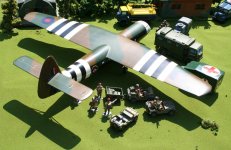
If successful, this reinforcement should allow 4th Parachute Brigade to attempt to get into Arnhem.
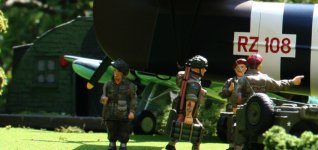
Even before starting at this point, it is necessary to go back even further and describe what happened in the Divisional HQ and Airlanding Brigade areas from dawn of that Monday until the arrival of the second lift.
The mood at Divisional HQ on that first morning of Monday the 18th of September was still one of reasonable optimism, despite the absence of the divisional commander, as the substantial reinforcement of the second lift was expected soon.
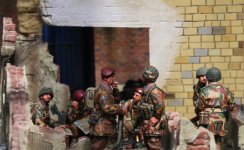
When that happened, it was planned that the whole of the remainder of the division would move into Arnhem. The lift was expected in mid-morning but in the event was delayed. It was a period that was relatively uneventful compared with the fierce fighting taking place elsewhere, but there were some significant moves and important actions which should be noted.
The next element of the story to discuss is regarding the arrival of the second lift on Monday 18 September.

If successful, this reinforcement should allow 4th Parachute Brigade to attempt to get into Arnhem.

Even before starting at this point, it is necessary to go back even further and describe what happened in the Divisional HQ and Airlanding Brigade areas from dawn of that Monday until the arrival of the second lift.
The mood at Divisional HQ on that first morning of Monday the 18th of September was still one of reasonable optimism, despite the absence of the divisional commander, as the substantial reinforcement of the second lift was expected soon.

When that happened, it was planned that the whole of the remainder of the division would move into Arnhem. The lift was expected in mid-morning but in the event was delayed. It was a period that was relatively uneventful compared with the fierce fighting taking place elsewhere, but there were some significant moves and important actions which should be noted.
Louis Badolato
Lieutenant General
- Joined
- Apr 25, 2005
- Messages
- 17,469
The first two photos bring back fond memories of a great day spent with you, Kevin, and many other great friends, some of whom, like Larry and Chuck, are only fond memories ...One feature of the treatment of the Battle of Arnhem, is that by describing significant actions through to their conclusion, means that it will be necessary to go back in time to follow the next thread within the main story.
The next element of the story to discuss is regarding the arrival of the second lift on Monday 18 September.
View attachment 347395
If successful, this reinforcement should allow 4th Parachute Brigade to attempt to get into Arnhem.
View attachment 347396
Even before starting at this point, it is necessary to go back even further and describe what happened in the Divisional HQ and Airlanding Brigade areas from dawn of that Monday until the arrival of the second lift.
The mood at Divisional HQ on that first morning of Monday the 18th of September was still one of reasonable optimism, despite the absence of the divisional commander, as the substantial reinforcement of the second lift was expected soon.
View attachment 347408
When that happened, it was planned that the whole of the remainder of the division would move into Arnhem. The lift was expected in mid-morning but in the event was delayed. It was a period that was relatively uneventful compared with the fierce fighting taking place elsewhere, but there were some significant moves and important actions which should be noted.
panda1gen
Major
- Joined
- Jul 29, 2005
- Messages
- 6,347
Despite the confidence however, the extreme difficulty facing 1st Airborne in reaching the Arnhem bridge, was not yet appreciated at HQ. At 8 a.m., the Divisional HQ started to drive a mile and a half along the Utrechtseweg, to take up a temporary position in a side turning, among a pleasant avenue of trees.

In practice it was not a good place for communications. None of the Divisional Signals, Phantom or public-relations sets could contact England, so there was no means of even knowing that the second lift would be delayed.
The morning was still generally peaceful. Captain Peter Fletcher was with the glider pilots accompanying Divisional HQ. He reported,
'We started to move towards Arnhem in single file, past pleasant suburban houses.
A wash and a shave during one of the many hold-ups in one of the many friendly houses en route seemed a good exchange for half a bar of chocolate.'
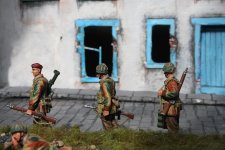
Not far away, the RASC needed more vehicles to supply the troops,
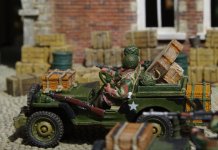
... so they sent five men on foot into Heelsum, looking for vehicles to transport ammunition. Driver Jack Taylor was one of them:
“In the centre of the village we found a bus which, I think, had come from Arnhem to collect early-morning passengers. We told the driver that we needed his bus and would he get out. He said it was a left-hand drive, and it would be better if he drove it for us, and he would do so on condition that, if we were captured, we would say that we had forced him into it”.
Taylor thought he seemed quite proud to drive for them. Later in the day, however, the vehicle was ambushed. The Dutch driver and one of the RASC men were killed.

In practice it was not a good place for communications. None of the Divisional Signals, Phantom or public-relations sets could contact England, so there was no means of even knowing that the second lift would be delayed.
The morning was still generally peaceful. Captain Peter Fletcher was with the glider pilots accompanying Divisional HQ. He reported,
'We started to move towards Arnhem in single file, past pleasant suburban houses.
A wash and a shave during one of the many hold-ups in one of the many friendly houses en route seemed a good exchange for half a bar of chocolate.'

Not far away, the RASC needed more vehicles to supply the troops,

... so they sent five men on foot into Heelsum, looking for vehicles to transport ammunition. Driver Jack Taylor was one of them:
“In the centre of the village we found a bus which, I think, had come from Arnhem to collect early-morning passengers. We told the driver that we needed his bus and would he get out. He said it was a left-hand drive, and it would be better if he drove it for us, and he would do so on condition that, if we were captured, we would say that we had forced him into it”.
Taylor thought he seemed quite proud to drive for them. Later in the day, however, the vehicle was ambushed. The Dutch driver and one of the RASC men were killed.
Louis Badolato
Lieutenant General
- Joined
- Apr 25, 2005
- Messages
- 17,469
Kevin,
Great photo but he looks awfully cheerful considering the circumstances.
panda1gen
Major
- Joined
- Jul 29, 2005
- Messages
- 6,347
One unit pushed on even further towards Arnhem, to become the first element of the division to take up a permanent position in Oosterbeek.
No. 3 Battery of the Airlanding Light Regiment was designated to support the 1st Parachute Brigade and needed to be closer to Arnhem to bring its 75-millimetre guns within range.
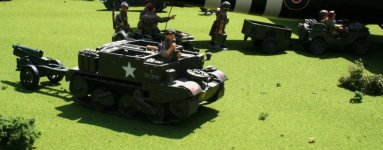
The very first to arrive was F Troop with Lieutenant Frank Moore in charge:
“The location wasn't pre-planned; we just went along through Oosterbeek looking for a good position, but the country was so close that we found nothing suitable until we reached the fields around the quiet little church on the lower road. We took up position in a small field and orchard just south-east of the church, with our command post in the church porch on that side.
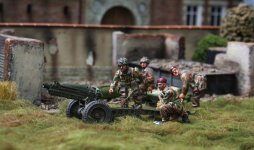
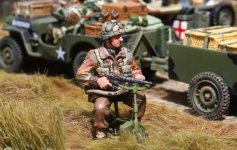
The other troops found slightly less open locations west of the church and they thought we had a super position. After those pre-operational briefings, we didn't think that any part of the German Army would have the effrontery to attack us. All we were looking for was an open space which allowed us to fire up to the bridge area. We didn't know it would become the front line later”.

No. 3 Battery of the Airlanding Light Regiment was designated to support the 1st Parachute Brigade and needed to be closer to Arnhem to bring its 75-millimetre guns within range.

The very first to arrive was F Troop with Lieutenant Frank Moore in charge:
“The location wasn't pre-planned; we just went along through Oosterbeek looking for a good position, but the country was so close that we found nothing suitable until we reached the fields around the quiet little church on the lower road. We took up position in a small field and orchard just south-east of the church, with our command post in the church porch on that side.


The other troops found slightly less open locations west of the church and they thought we had a super position. After those pre-operational briefings, we didn't think that any part of the German Army would have the effrontery to attack us. All we were looking for was an open space which allowed us to fire up to the bridge area. We didn't know it would become the front line later”.

panda1gen
Major
- Joined
- Jul 29, 2005
- Messages
- 6,347
Whilst they were waiting for the Second Lift,
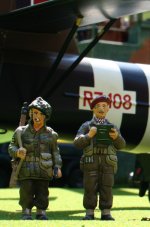
local people brought out milk and sandwiches to the gunners. They also warned them of a solitary German in a nearby house ....
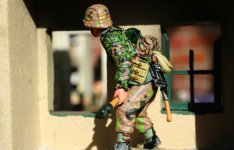
.... he was soon taken prisoner by some glider pilots who had remained with the guns they had flown from England.
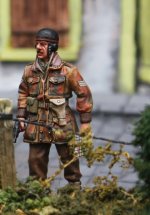
Captain Randall Martin, the Light Regiment's Medical Officer, went along to a nearby house and asked the lady who came to the front door if her home could become his Regimental Aid Post where any lightly wounded could be treated.
Mrs Kate ter Horst said, 'Yes.'
That was quiet Oosterbeek on that Monday morning, although one of the Reconnaissance Squadron's patrols which went along the Utrechtseweg ...
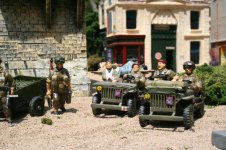
... into the upper village later in the morning encountered a small German force, and one trooper was killed there.
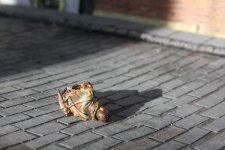

local people brought out milk and sandwiches to the gunners. They also warned them of a solitary German in a nearby house ....

.... he was soon taken prisoner by some glider pilots who had remained with the guns they had flown from England.

Captain Randall Martin, the Light Regiment's Medical Officer, went along to a nearby house and asked the lady who came to the front door if her home could become his Regimental Aid Post where any lightly wounded could be treated.
Mrs Kate ter Horst said, 'Yes.'
That was quiet Oosterbeek on that Monday morning, although one of the Reconnaissance Squadron's patrols which went along the Utrechtseweg ...

... into the upper village later in the morning encountered a small German force, and one trooper was killed there.

Louis Badolato
Lieutenant General
- Joined
- Apr 25, 2005
- Messages
- 17,469
Memories ... good times! Thanks for the reminder, Kevin!
Users who are viewing this thread
Total: 9 (members: 0, guests: 9)


